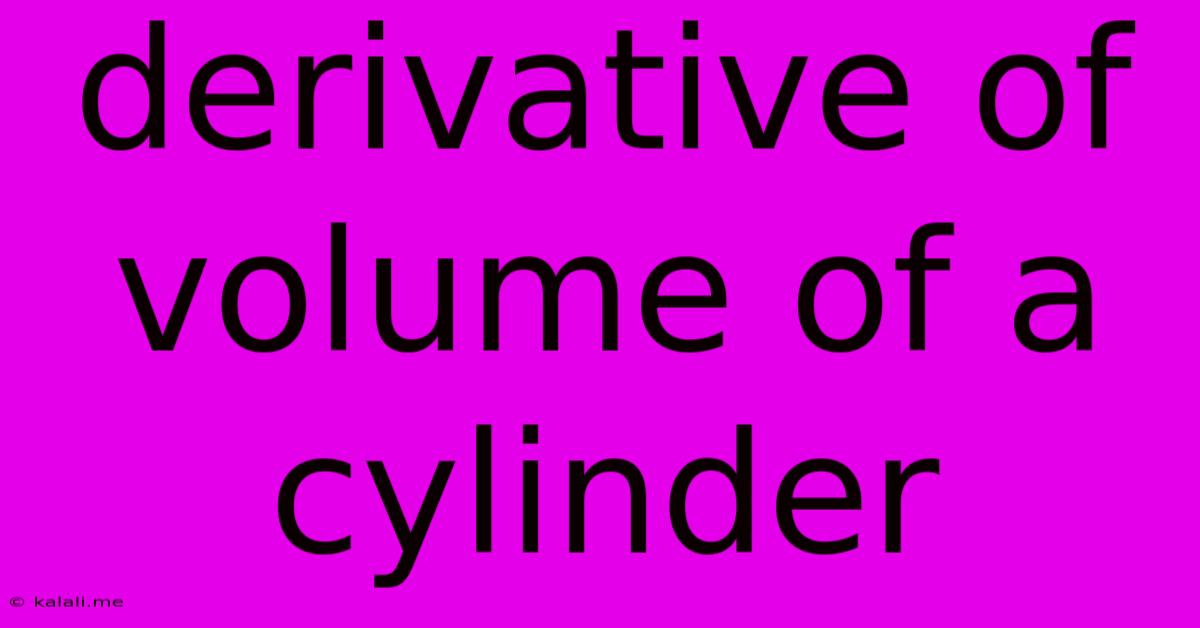Derivative Of Volume Of A Cylinder
Kalali
Jun 14, 2025 · 3 min read

Table of Contents
Finding the Derivative of the Volume of a Cylinder: A Step-by-Step Guide
This article provides a comprehensive guide on how to derive the formula for the rate of change of the volume of a cylinder, focusing on both the mathematical process and its practical applications. Understanding this derivative is crucial in various fields, including engineering, physics, and calculus. We'll explore different scenarios, including cases where the radius, height, or both are changing with respect to time.
The volume of a cylinder is given by the formula: V = πr²h, where 'r' represents the radius and 'h' represents the height. This simple formula forms the foundation for our derivative calculations.
Deriving the Volume with Respect to Radius (r)
Let's first consider the scenario where the height (h) remains constant, and only the radius (r) changes. To find the derivative of the volume with respect to the radius, we treat 'h' as a constant and apply the power rule of differentiation:
dV/dr = d(πr²h)/dr = 2πrh
This equation tells us that the rate of change of the volume with respect to the radius is directly proportional to both the radius and the height. A larger radius or height will result in a greater change in volume for a given change in radius.
Practical Application: Imagine a cylindrical tank being filled with liquid. If the height remains constant, this derivative helps determine how quickly the volume increases as the radius expands.
Deriving the Volume with Respect to Height (h)
Now, let's consider the case where the radius (r) remains constant, and only the height (h) changes. Again, we apply the power rule, this time treating 'r' as a constant:
dV/dh = d(πr²h)/dh = πr²
This shows that the rate of change of volume with respect to height is directly proportional to the square of the radius. A larger radius leads to a more significant increase in volume for a given change in height.
Practical Application: Consider a cylindrical container being filled with a liquid at a constant rate. This derivative allows us to calculate the rate at which the height increases as the volume changes.
Deriving the Volume with Respect to Both Radius and Height (r and h)
In a more complex scenario, both the radius and height might change simultaneously. This requires the application of partial derivatives. We'll use the notation ∂V/∂r and ∂V/∂h to denote partial derivatives:
∂V/∂r = 2πrh (Rate of change of volume with respect to radius, holding height constant) ∂V/∂h = πr² (Rate of change of volume with respect to height, holding radius constant)
Using the chain rule, if both r and h are functions of time (t), we can find the total rate of change of the volume with respect to time (dV/dt):
dV/dt = (∂V/∂r)(dr/dt) + (∂V/∂h)(dh/dt) = 2πrh(dr/dt) + πr²(dh/dt)
This equation is extremely powerful. It allows us to determine the overall change in volume given the rates of change of both radius and height.
Practical Application: This could be used to model the change in volume of a balloon being inflated, where both the radius and height are increasing simultaneously.
Conclusion
Understanding the derivative of the volume of a cylinder provides a powerful tool for analyzing and predicting changes in volume based on changes in its dimensions. Whether dealing with a constant height, constant radius, or changes in both, the mathematical approaches outlined above offer a clear and precise method for solving a variety of real-world problems. Remember to correctly identify which variable(s) are changing and apply the appropriate differentiation technique (standard differentiation, partial differentiation, or the chain rule) to obtain the accurate rate of change.
Latest Posts
Latest Posts
-
Which Of The Following Em Waves Has The Highest Frequency
Jun 14, 2025
-
Which Surface Would Have The Highest Albedo
Jun 14, 2025
-
How Many Bar In 1 Atm
Jun 14, 2025
-
Which Of The Following Statements Is A Tautology
Jun 14, 2025
-
How To Insert A Tab In Html
Jun 14, 2025
Related Post
Thank you for visiting our website which covers about Derivative Of Volume Of A Cylinder . We hope the information provided has been useful to you. Feel free to contact us if you have any questions or need further assistance. See you next time and don't miss to bookmark.